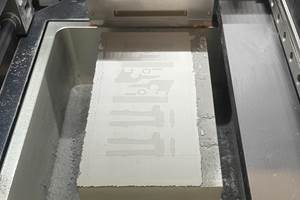BMF Expands Material Options for Microscale 3D Printers With High-Performance Resins
The company says the new high-performance materials can unlock advanced applications across electronics, medical and industrial sectors.
Boston Micro Fabrication (BMF) is expanding the range of its microArch series 3D printers with the addition of four new materials, which include 3D Systems’ Figure 4 HI TEMP 300-AMB, BASF Ultracur3D 3280 and BMF resins HTF and SR. The new material options are intended to enhance the ability of the company’s ultrahigh precision 3D printing solutions to meet the diverse and demanding needs of industries such as aerospace, medical devices, electronics and biotechnology.
By adding these advanced materials to its lineup, BMF says it is enabling engineers and researchers to create fit-for-purpose precision parts with more accuracy, heat resistance and material performance.
New Material Options
3D Systems’ Figure 4 HI TEMP 300-AMB
Well suited for extreme thermal environments, this production-grade, ultrahigh temperature-resistant plastic offers a heat deflection temperature (HDT) of over 300°C. With excellent rigidity and visualization properties, Figure 4 HI TEMP 300-AMB is well suited for HVAC components, motor enclosures and low-pressure molding, offering precise testing of high-temperature parts.
- Applications: HVAC systems, consumer appliances, motor enclosures and low-pressure molding.
- Key Benefits: HDT over 300°C, no secondary thermal postcure required and superior rigidity.
BASF Ultracur3D 3280
A ceramic-filled resin that boasts exceptional stiffness (Young’s modulus of 10 GPa) and a high heat deflection temperature (>280°C), Ultracur3D 3280 is well suited for tooling, molding and wind tunnel testing. Its low viscosity and stable suspension make it both easy to handle and print, positioning it as an excellent material in the field of high-temperature and high-stiffness applications.
- Applications: Tooling, wind tunnel testing, and mold inserts.
- Key Benefits: Superior stiffness and temperature performance, high stability, and easy to print.
HTF (High-Temp)
Designed by BMF, HTF is a high-temperature-resistant, tough and biocompatible resin. It is autoclave-sterilizable and well suited for applications where biocompatibility and flexibility are key. With an HDT of 152°C and compatibility with aerospace and biotech applications, HTF offers versatility across a range of demanding environments.
- Applications: Aerospace, precision electronics and biotechnology.
- Key Benefits: Biocompatibility, autoclave sterilizable and higher flexibility than comparable materials.
SR (Sacrificial Resin)
A soluble, sacrificial material, SR enables the creation of single-use molds for parts produced with other materials that cannot be easily printed, such as polypropylene (PP) or polyoxymethylene (POM). This material opens new possibilities for prototyping and low-volume production by reducing the cost and complexity of micro-injection molding.
- Applications: Single-use molds, low-volume part production and PDMS applications.
- Key Benefits: Dissolves in a sodium hydroxide solution and facilitates cost-effective part production.
New Possibilities for Micromanufacturing
The company says each of these materials complements the capabilities of its microArch 3D printers, ensuring that industries like medical devices, electronics, and aerospace can continue to push the boundaries of what’s possible with microscale 3D printing.
“Before discovering BMF, Makuta struggled to find a cost-effective solution for prototyping due to the size and complexity of their molded parts. Traditional methods like aluminum or urethane molds often fell short in holding the required tolerances, and the expense of creating entirely new molds was prohibitive,” says Taki Yamada, Makuta director of business development. “Using BASF Ultracur3D 3280 on BMF’s microArch system, we were blown away by the impeccable finish and precision of the first 3D printed mold inserts we received. Not only were they able to reproduce intricate features flawlessly but they also maintained the tight tolerances our projects demand,”
The Z-Axis Connector Co. says BMF has completely transformed how it approaches connector manufacturing. “Previously limited to tolerances of 5 thousandths with traditional methods, BMF allowed us to achieve tolerances of 1 to 2 thousandths, opening new possibilities for compact, high-performance connectors,” says said George Glatts, Z-Axis Connector Co. owner. “Their platform also enabled us to use 3D Systems’ Figure 4 HI TEMP 300-AMB material that can withstand temperatures up to 300°C, meeting the demands of standard electronic assembly processes, enhancing efficiency and allowing us to create more compact, innovative designs. With BMF, we’ve reduced time and costs while delivering precision and performance that surpass industry standards.”
Related Content
Italian Furniture Maker Uses WASP Technology to Create 3D Printed Pendant Lamps
The versatility of 3D printed ceramic enabled the designers to shape a weave reminiscent of the beehive concept, enhanced by the light source.
Read MoreMoldJet Technology Enables High-Throughput Metal, Ceramic Additive Manufacturing
Formnext 2023: Tritone Technologies’ additive manufacturing solutions enable industrial throughput of accurate parts with a range of metal and ceramic materials.
Read MoreHorizon Expands Services With Subcontract Micro AM Production, Design Support
Horizon also offers a suite of proprietary coating processes that enable customers to successfully expand the functionality of parts which are typically produced in plastics on commercially available micro additive manufacturing platforms.
Read MoreAM 101: What Is Binder Jetting? (Includes Video)
Binder jetting requires no support structures, is accurate and repeatable, and is said to eliminate dimensional distortion problems common in some high-heat 3D technologies. Here is a look at how binder jetting works and its benefits for additive manufacturing.
Read MoreRead Next
Crushable Lattices: The Lightweight Structures That Will Protect an Interplanetary Payload
NASA uses laser powder bed fusion plus chemical etching to create the lattice forms engineered to keep Mars rocks safe during a crash landing on Earth.
Read MoreAlquist 3D Looks Toward a Carbon-Sequestering Future with 3D Printed Infrastructure
The Colorado startup aims to reduce the carbon footprint of new buildings, homes and city infrastructure with robotic 3D printing and a specialized geopolymer material.
Read MorePostprocessing Steps and Costs for Metal 3D Printing
When your metal part is done 3D printing, you just pull it out of the machine and start using it, right? Not exactly.
Read More






















